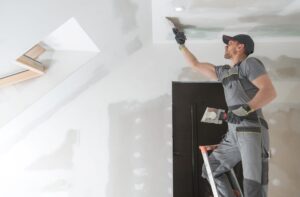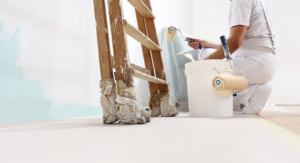Drywall damage from nails, screws, picture frame hangers, and other fasteners can be patched and made unnoticeable with a little drywall compound and a putty knife.
Once the spackling compound is dry, smooth the area like the rest of your wall or ceiling. Then, you or your interior house painters can paint over it. For more information about drywall repair visit NWA Painter.

Drywall isn’t the toughest construction material on the planet, and it is susceptible to damage from water. Whether it comes from a roof leak or a flood, excessive moisture in drywall can cause discoloration, bubbling, and even mold. If you notice any of these issues, it’s time to call a drywall repair specialist.
Moisture can also lead to other problems with your drywall, including fungi growth and crumbling or flaking. Fungi grow best in damp environments, and prolonged exposure can cause health issues for you and your family. The good news is that there are a few simple ways to prevent moisture issues and avoid needing drywall replacement.
First, keep humidity levels in your home low and clean your drywall regularly. Dust and dirt can trap moisture on drywall surfaces, leading to many problems.
Second, ensure that your walls are properly insulated, and your home’s air vents are not blocked by furniture or other items. Blocking these vents can hinder airflow and encourage moisture buildup, leading to various problems.
Third, check your drywall regularly for signs of water damage. You can do this by using a non-penetrating moisture meter or removing baseboards to look at the studs behind your walls. If the drywall is soft, it’s probably time to replace it.
While most holes in drywall can be patched up, large holes should prompt you to have the area replaced. Holes can weaken the structural integrity of your walls, which could lead to a dangerous situation down the road. A drywall repair expert can patch these areas to reduce the chance of future problems. They can also sand and prime the new sections before they paint, making them look as good as the rest of your walls.
Drywall, or gypsum board or sheetrock, is a common building material used in homes of all sizes. But like any other surface in your home, it can get damaged by various factors. If your drywall is damaged to the point that you need to replace it, here are a few tips for selecting a contractor that will provide quality service.
The first step in repairing drywall is to remove any debris stuck to the surface carefully. Next, cut any ragged edges sticking out from the wall using a utility knife or razor blade. This will help protect your hands from cuts if you need to touch the damaged area while working.
Once the drywall has been removed, use your stud finder to locate the studs that frame the damaged area. Then, mark their locations with a pencil so you know where to screw in the new patch or furring strip. Once the area has been repaired, prime and paint the drywall with latex paint to avoid moisture issues in the future.
Cracks and holes in drywall are some of the most common drywall problems. These can be caused by various factors, including the weight of furniture or pictures being hung on the walls, the vibrations from heavy machinery in your home, and even the pressure of your family members’ bodies as they move around. Luckily, these problems are easy to fix.
If the damage is just a small nick or crack, you can often get away with using a spackle to fill in the damaged spot. This type of repair takes only minutes to complete, but you’ll need to wait for the spackle to dry before painting the area.
Larger holes in drywall require a bit more work to repair. First, you’ll need to cut a square or rectangle out of a piece of new drywall that will fit the hole. Then, screw the drywall patch to the existing wall, using long enough screws to penetrate the studs through the back of the drywall and into the wood framing underneath. You’ll also need to tape and mud the seams.
A few dents, scrapes, or holes in your walls can be easily fixed with a little spackle and some touch-up paint. But what about if the damage goes deeper than a few blemishes on the surface of your wall? Drywall repairs can be challenging for even the most stubborn DIYer, especially if you need to know what you’re doing. If you want your repairs to look flawless, a professional contractor offering drywall repair and interior painting services is the way to go.
Correcting the problem as soon as possible if your drywall is damaged is essential to avoid long-term issues. Sometimes, you may need to replace the drywall entirely, especially if there are mold or water damage signs. Mold can be a serious health issue and should not be ignored. Water damage from a leaky pipe or plumbing issue can be equally dangerous for your drywall and should be addressed quickly.
When it comes to fixing drywall, there are three common methods: patching, mudding, and sanding. Most of the time, minor dents and holes can be covered with a small spackle or a lightweight drywall compound that is smoothed and sanded to produce a perfectly unblemished surface. When filing, wear a dust mask or dual-cartridge respirator to protect yourself from the fine gypsum and silica particulates created when sanding drywall.
A mesh drywall patch is usually the best solution for larger holes and damage. These patches are available online or at most hardware stores and look like screens that stick to the wall over the hole. When applying the patch, use a putty knife to apply drywall compound over the entire patch surface and then sand until smooth.
If you’re repairing a large hole, mark the center of the stud with a pencil or chalk line before beginning work so that you can find and locate the stud. The studs are where the utility lines and pipes run, and it’s important to identify them before cutting or drilling into the drywall in case you come across any electrical wires.
Aside from major flooding and water damage, drywall visibly breaking down should be replaced rather than repaired. This is because the drywall may have become brittle, crumbling, or soft, and it’s not a good idea to try to save a drywall sheet in poor condition. Simply installing a new piece of drywall will be easier and faster.
Minor blemishes, such as small holes, dents, or scrapes, are often easy for homeowners to patch. A patch kit usually includes a self-adhesive mesh patch that sticks to the existing drywall and covers the hole. Homeowners can also use a dab of spackle and sand and touch up the interior painting with fresh paint to hide the repair.
Larger holes from banging a doorknob or nails can often be fixed by installing a new drywall panel. Ensuring the replacement is properly anchored to wall studs or ceiling joists is important. The studs and beams should be inspected for damage and any needed repairs. It’s best to work with professionals who know the correct way to anchor drywall to wood to avoid problems down the road.
Hairline cracks in drywall are another type of problem that is generally within the capabilities of most homeowners. These typically appear above and below windows and doors, caused by lumber shrinkage or settling in the house frame. Homeowners can use a drywall knife to sand the crack smooth and apply a thin coat of joint compound with a putty knife. It’s important to use mesh joint tape on the borders of the crack to strengthen the repair, reduce shifting, and help prevent future cracking.
Cracks that are wider than 18″ or those occurring along with sagging walls or ceilings could indicate an issue with the structure of your home and should be fixed by professional drywall installers rather than papered over. It’s important to find the cause of these larger cracks and address it. Otherwise, you risk having the problem reappear over time.
In general, repairing drywall isn’t expensive. However, it’s a job that can be labor intensive. The size of the project can drive up the overall cost, how many rooms are affected, and the type of drywall being repaired or replaced.

